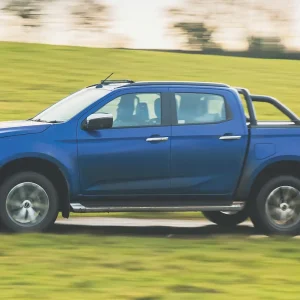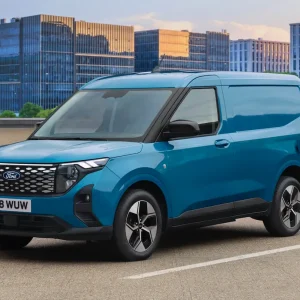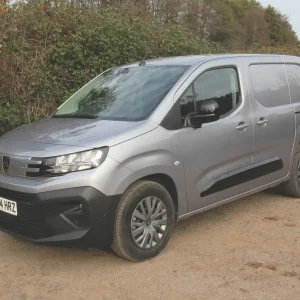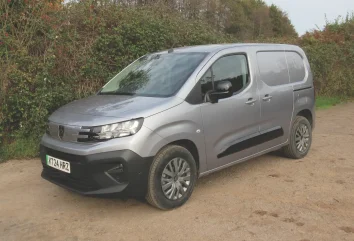
Peugeot’s Partner is enjoying a remarkable run of success. Last year sales levels were such that it could justly claim to be Britain’s favourite compact van overall, while the battery-powered e-Partner version became the country’s most-popular compact electric van.
Peugeot is a member of the vast Stellantis automotive group which also embraces Citroen, Fiat Professional and Vauxhall. All three of these brands have an equivalent model to the Partner (Berlingo, Doblo, and Combo respectively) based on the same platform, and all four vehicles have been upgraded and restyled, with Stellantis attempting to appeal to different sectors of the market with each make.
Persuading businesses to opt for electric light commercials is proving to be an uphill struggle for manufacturers, with overall demand staying static in 2024.
Fearful of government-imposed fines if they fail to meet zero-emission sales targets, van makers are straining every sinew to persuade customers to go zero-emission, and the updates to the British-built e-Partner announced in late-2023 clearly did its fortunes no harm at all.
They include external styling changes, a revised cab interior with a new dashboard, and – most importantly – an increased range between recharges.
The Partner is up for grabs in short- and long-wheelbase guise, with cargo volumes of 3.3m3 and 3.9m3 respectively. The long-wheelbase model is also available as a five-seater crew van.
Partner customers can choose either a 100hp or a 130hp BlueHDi 1.5-litre diesel, while the electric e-Partner comes with a 100kW (136hp) electric motor.
We decided to sample the short-wheelbase e-Partner in top-of-the-range Asphalt trim. Professional is the entry-level specification, with the newly-introduced Professional Plus trim acting as a bridge between the bottom and top.
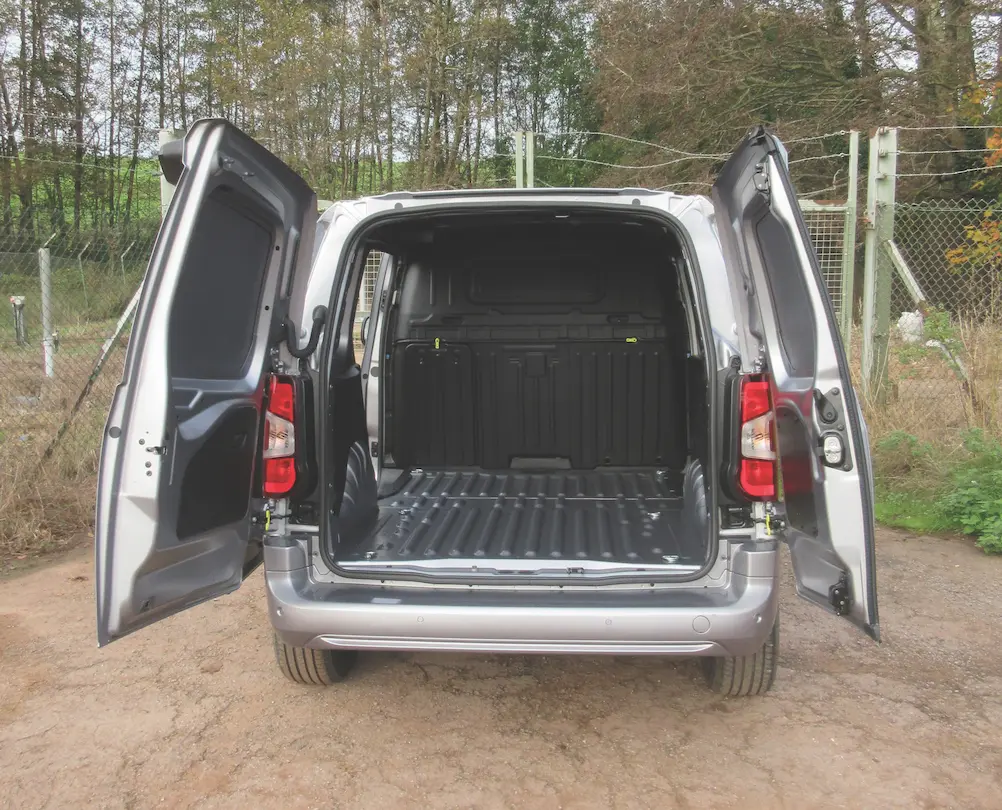
Load bay
Access to the 3.3m3 cargo area is by means of a sliding nearside door and through twin rear doors which can be swung through 90º, and through almost 180º if the stays are released. The opaque back doors are asymmetric, with the narrower of the two on the offside.
A full-height unglazed steel bulkhead should protect the cab’s occupants if the load shifts forwards if it hasn’t been secured to the six floor-mounted lashing rings that are provided.
The slim wheel boxes make it easier to slide a pallet of goods on board, but care needs to be taken. While the sides and doors are partially protected against minor damage by plastic panels, there is no protection for the floor.
We’d suggest that the entire cargo bay is timbered out to provide a proper defence against scratches and scrapes.
The Partner comes with a three-seater cab. If you need to carry extra-long items then it is worth noting that the cab seat closest to the passenger door can be folded forwards, creating an extension to the load bed.
Open a hatch in the bottom of the bulkhead, and lengthy cargo can be slid through. Doing so increases load length from 1,817mm to an impressive 3,090mm.
What we can only describe as a giant sock is provided to cover the end of such loads, in order one assumes to keep the cab clean if they are dirty and perhaps enhance safety. We do wonder how often it is used, though.
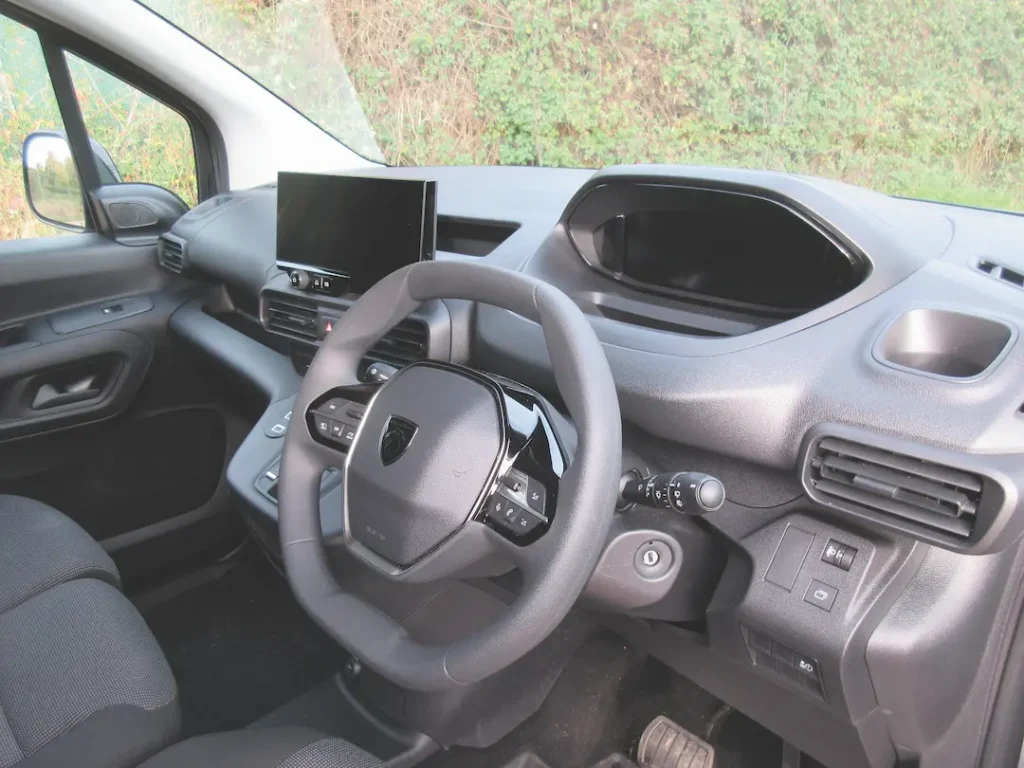
Interior and equipment
Without a doubt one of the e-Partner Asphalt’s best features is a rear-view camera that lets you keep an eye on the traffic directly behind you at all times.
One of the drawbacks of driving a van with unglazed rear doors is that the interior rear-view mirror is rendered useless. On the e-Partner, the camera does the job instead.
It is at the heart of the van’s Dynamic Surround View package which also includes blind spot detection and Flankguard, which tells the driver how close the vehicle’s sides are getting to obstructions.
Front and rear parking sensors are included in the deal as is a Visiopark 180 reversing camera. The angle it covers can be altered to give you a wider view of your surroundings.
With Asphalt trim you get air-conditioning, cruise control, electric windows and electrically heated, foldable, and adjustable exterior mirrors.
You also get an i-Cockpit 10in touch-screen – i-Cockpit is the differentiating factor between the Partner and its sister Stellantis models – with Peugeot’s i-Connect infotainment package. It includes TomTom 3D connected satellite navigation, a DAB radio, Bluetooth, Wi-Fi mirroring so you can connect a portable device to the screen, and two USB ports. Provided too is an ‘OK Peugeot’ intelligent voice assistant.
Happily, the heating and ventilation system and the air-conditioning are controlled by user-friendly manual switches on the fascia, and you switch the radio on and off and turn the volume up and down manually too. You’ll find remote controls on the steering wheel and the driver’s seat and wheel are both height-adjustable.
You get an electronic parking brake, the dashboard boasts a 12v power socket, and the intelligent i-Cockpit 10in digital instrument panel divulges all sorts of useful information including your remaining range, the amount of charge left in the battery and the speed that applies to the road you are travelling down. You are warned if you breach it.
Other onboard safety systems include ABS, Electronic Stability Control, Electronic Brakeforce Assist, Electronic Brakeforce Distribution, Hill Start Assist, Lane Keep Assist and Advanced Emergency Braking System.
Driver, passenger, side and curtain airbags are fitted, as are front fog lights. Disc brakes are installed all round, the headlights dip automatically at night, and the wipers start working the minute rain spatters across the windscreen.
We’ve said it before, and we’ll say it again – we heartily dislike the idea of trying to shoehorn three seats into a cab that really only has room for two.
The hapless middle passenger will find their shoulder room is restricted and their right knee is pressed up against a moulding that bows outwards from the fascia. Not where you want to be perched if you are on a long journey.
On the positive side, the back of the middle seat folds downwards and turns into a desk which the driver can use to complete paperwork. Some businesses still rely on paper.
In-cab storage facilities include a full-width shelf above the windscreen, a lidded, but not lockable, glove-box with two shelves below it, and two bins in each of the doors. There’s a cup-holder at each end of the dashboard.
Pull up the middle seat’s cushion and you will find a hidden compartment underneath – just the place to stash your smartphone.
Our e-Partner rode on 16in steel wheels decorated with plastic trims and shod with Bridgestone Turanza 215/65 R16 tyres. A TPMS – Tyre Pressure Monitoring System – watches over them.
Our test van was equipped with an optional spare wheel – something to be welcomed given the appalling state of the highways.
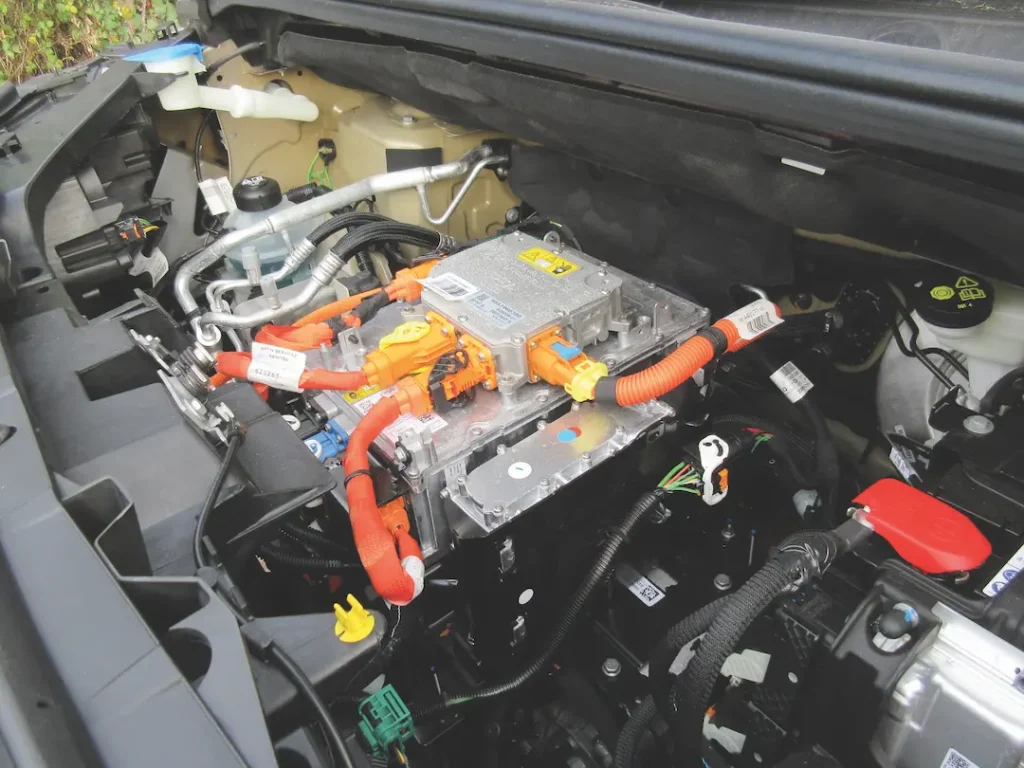
Powertrain
A 52kWh lithium-ion battery delivers power to an electric motor pushing out up to 270Nm of torque, and the front-wheel-drive e-Partner comes with a 7kW onboard charger.
Replenishing the battery from 0–100% using a single-phase 7.4kW wallbox should take no more than seven-and-a-half hours, says Peugeot, falling to just over five hours if you are using a three-phase 11kW wallbox. Plug your vehicle into a 100kW DC rapid charger and you should be able to get it from 0–80% in no more than 30 minutes, the company contends.
Plug the vehicle in overnight and you can programme when you want the battery to be charged, and how early you want the cab heater to come on before you depart on your first run of the day.
Driving
Bizarrely, starting isn’t keyless. You have to insert and turn an ignition key as though the e-Partner were a traditional diesel or petrol van, even though there is nothing to ignite.
There is no gearshift lever, however. Instead, drivers are faced with a switch which allows them to select Neutral, Reverse or Drive.
They can also make use of another switch which allows them to select from one of three different drive modes which determine the level of performance they will enjoy.
Opt for Power and you will take off like the proverbial rocket. It’s ideal if you need to get past slow-moving traffic in a hurry, but watch out for lurking speed cameras.
The more use you make of Power mode, the faster you’ll drain the battery. If that
is a worry then use the Eco setting instead, but if you do then you’ll accelerate less quickly, and won’t make the progress you might like to.
Most drivers will probably conclude that Normal mode is the best bet. It delivers sufficient on-highway grunt for most tasks and shouldn’t shorten your range unduly.
If range is a worry then make sure you make full use of the van’s regeneration system. It captures energy that would otherwise be lost when the van decelerates, and pumps it into the battery.
You can alter the level of regeneration by using paddles on either side of the steering wheel. The left-hand paddle boosts it, the right-hand paddle brings it back down again.
Use the most aggressive setting and it will slow you down the way a retarder on a heavy commercial vehicle does, which can mean you have to touch the brake pedal less frequently.
Aside from a slight amount of body-roll as you swing through bends, the e-Partner handles well enough. It hops about a bit when empty, but a few bags of gravel in the back soon calm it down.
Without a diesel under the bonnet in-cab noise is muted, although the absence of an engine means that other sources of noise – the tyres for example – become a lot more noticeable. An acoustic alert system warns vulnerable road users such as cyclists and pedestrians that you are in their vicinity.
Range? Peugeot quotes a Worldwide Harmonised Light Vehicle Test Procedure combined figure of 213 miles between recharges, but this will be influenced, for good or ill, by the outside temperature, your driving style and how much weight you are carrying.
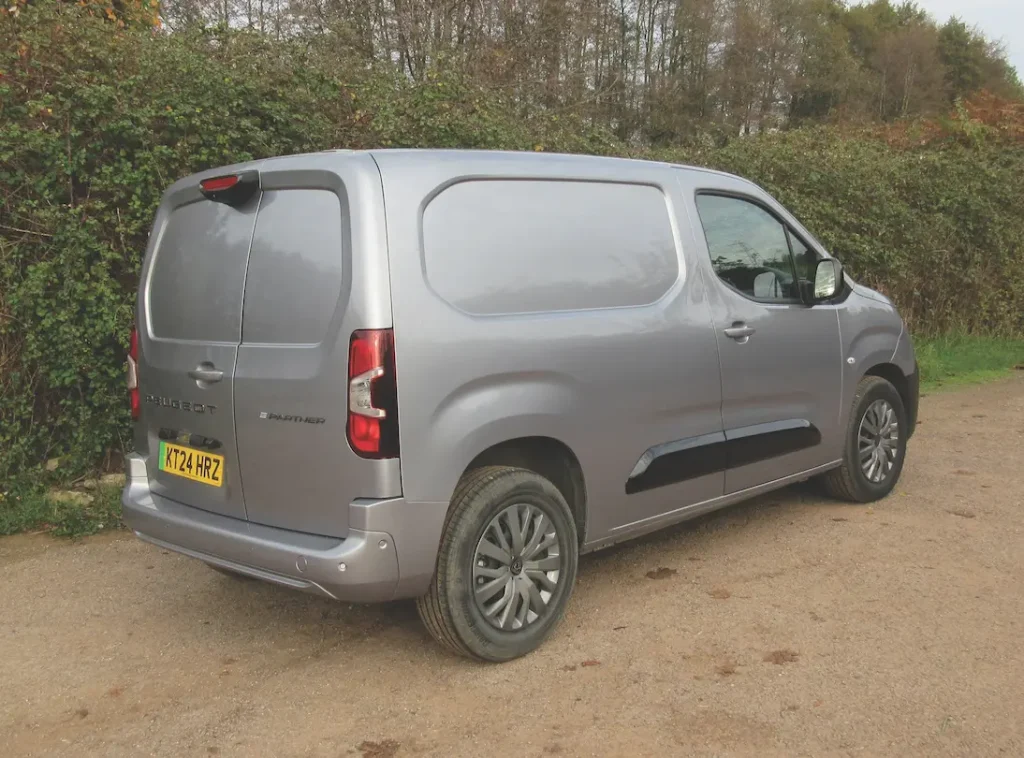
Operating
Service intervals are set at two years/25,000 miles and the LED headlamps should last forever. Warranty cover lasts for three years/60,000 miles, but the battery is covered by an eight-year/100,000-mile warranty that kicks in if its charging capacity falls to less than 70% of its capacity when new.
Our demonstrator was finished in extra-cost grey metallic paint with colour-keyed door handles and a colour-keyed rear bumper. Side rubbing strips protect the body’s exterior from minor damage.
| Model | Peugeot e-Partner Asphalt |
| Price (ex VAT nd PIVG) | £30,055 |
| Price range (ex VAT) | £20,750 – £34,850 |
| Gross payload | 759kg |
| Load length | 1,817mm |
| Load width (min/max) | 1,229mm/1,630mm |
| Load bay height | 1,200mm |
| Load volume | 3.3m3 |
| Loading height | 588mm |
| Rear door aperture | 1,241mm x 1,196mm |
| Side door aperture | 675mm x 1,072mm |
| Gross vehicle weight | 2,450kg |
| Braked trailer towing weight | 750kg |
| Engine size/power | 100kW (136hp) electric motor |
| Torque | 270Nm |
| Gearbox | 1sp |
| Range (combined WLTP) | 213 miles |
| Battery | 52kWh |
| CO2 | 0g/km |
| Warranty | 3yrs/60,000 miles (battery 8yrs/100,000 miles) |
| Service intervals | 2yrs/25,000 miles |
| Insurance group | 29E |
| Price as tested | £30,695 |
| Options | Metallic paint (£500), full-size spare wheel (£140) |
Rivals

Ford Transit Courier
On the face of it, it is a little odd that Ford has chosen to introduce a model that is so close to the Transit Connect, but there are marked differences between the two. A key one is that the Courier is up for grabs in battery-electric guise and Connect isn’t, although you can order it as a plug-in-hybrid. Winner of the What Van? Compact Van of the Year Award for 2025, the Courier is certainly a competent package.
| Price range (ex VAT) | £16,200-£28,000 |
| Load volume | 2.9m3 |
| Gross payload | 613-849kg |
| Engines | 100hp 1.5 diesel, 100hp, 125hp 1.0-litre petrol, 100kW electric |
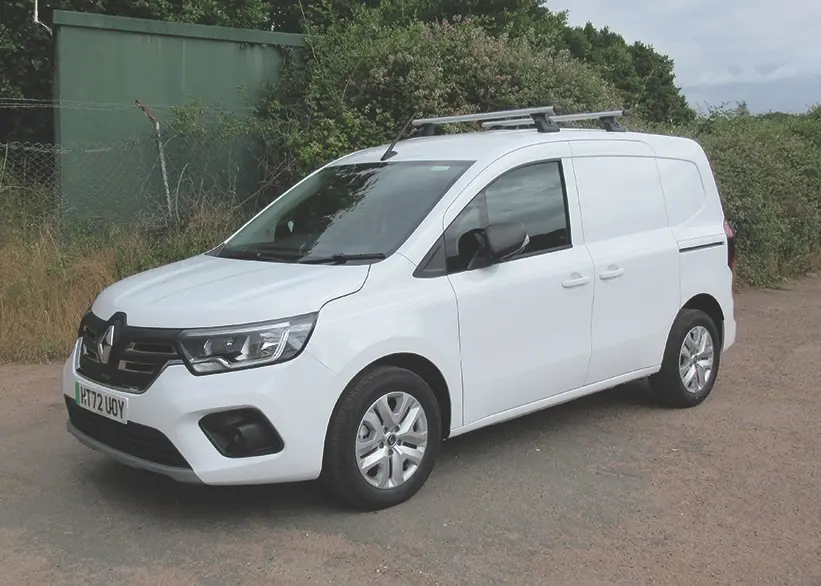
Renault Kangoo/Kangoo E-Tech
The Kangoo/Kangoo E-Tech underwent a revamp a couple of years or so ago, with a new front grille incorporating Renault’s latest visual identity plus more equipment delivered as standard. Every derivative gets a reversing camera and an electric parking brake among other goodies. There is no disputing the fact that both versions of the Kangoo are refined, practical and capable.
| Price range (ex VAT) | £21,825-£38,295 |
| Load volume | 3.3-4.2m3 |
| Gross payload | 608-975kg |
| Engines | 100hp 1.3 petrol, 95hp, 115hp 1.5 litre diesel, 90kW electric |
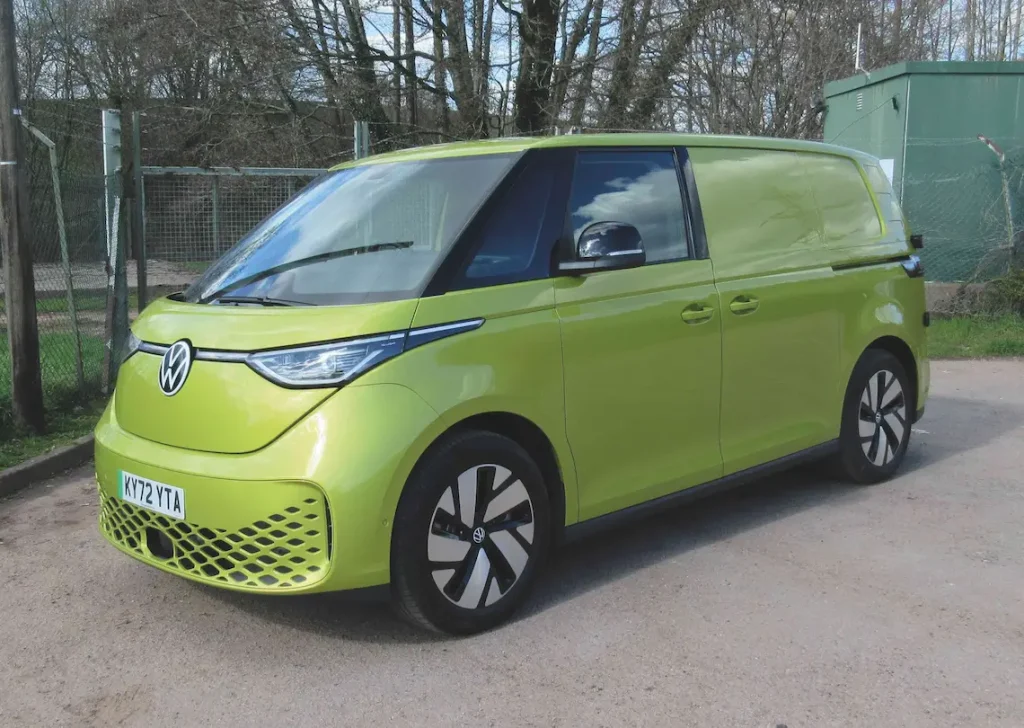
Volkswagen ID.Buzz Cargo
There really is nothing quite like VW’s ID.Buzz Cargo, and its distinctive looks make it a head-turner in the high street. Its payload capacity is mediocre, the price-tag is ridiculous, and (as with the Ford Transit Courier) there’s only one size available. On the other hand, at up to 340hp it certainly isn’t short on power, and its combined range of up to 277 miles wins it points. You can also have it with four-wheel-drive. We’re not sure it’s really a practical proposition as a cargo carrier – but we can’t help liking it.
| Price range (ex VAT) | £37,625-£42,875 |
| Load volume | 3.9m3 |
| Gross payload | 594-707kg |
| Engines | 210kW, 250kW electric |
The Final Verdict
| Design | 8/10 | Stellantis set itself the task of developing a zero-emission compact van for local urban and suburban work and it’s achieved its aim. |
| Cabin | 7/10 | Three-seater cab leaves too little room for the middle passenger but on the plus-side replacing the interior rear-view mirror with a camera works amazingly well. |
| Ride | 7/10 | Competent enough, and improves when you put some weight in the back. |
| Refinement | 8/10 | It’s electric, so it’s quiet, with no annoying squeaks or creaks. |
| Load area | 8/10 | Anybody carrying extra-long items will welcome the load-through facility. More secure than having to use a roof rack. |
| Handling/performance | 8/10 | Slight body roll doesn’t upset e-Partner’s ability to take corners and the Power mode setting packs bags of punch – if you don’t mind your range shortening. |
| Motor/transmission | 8/10 | Choice of drive modes and the regeneration paddles allow you to make the most of what’s on offer and achieve the balance of performance and range you need. |
| Standard equipment | 8/10 | Asphalt trim gets you most of the kit you’re likely to require, and we like the i-Connect infotainment package. |
| Operating costs | 8/10 | Long service intervals and a long battery warranty should help keep costs down. |
| What Van? subjective rating | 8/10 | Does exactly what it says on the tin. A choice you can’t quarrel with. |
| Overall rating | 8/10 |

